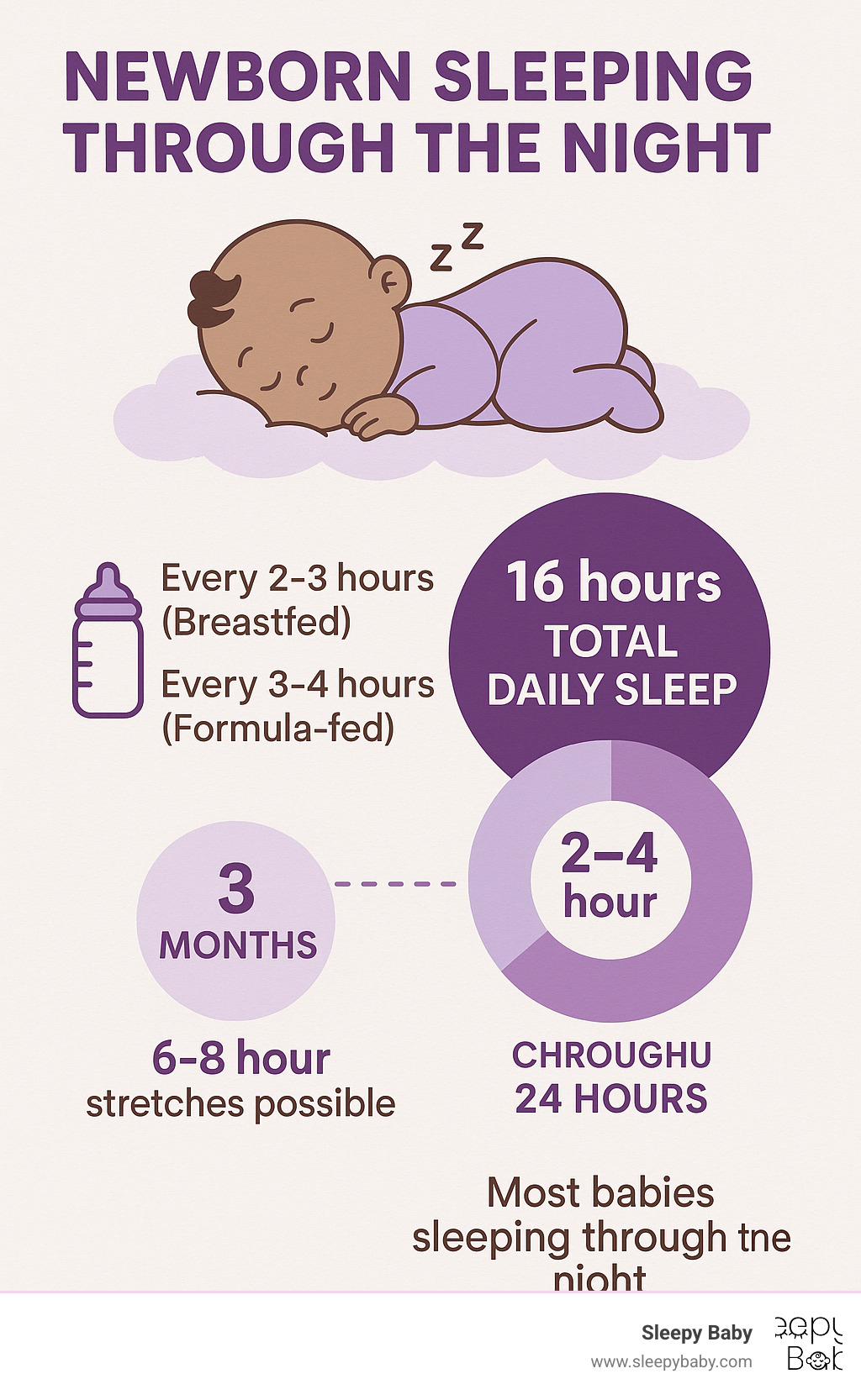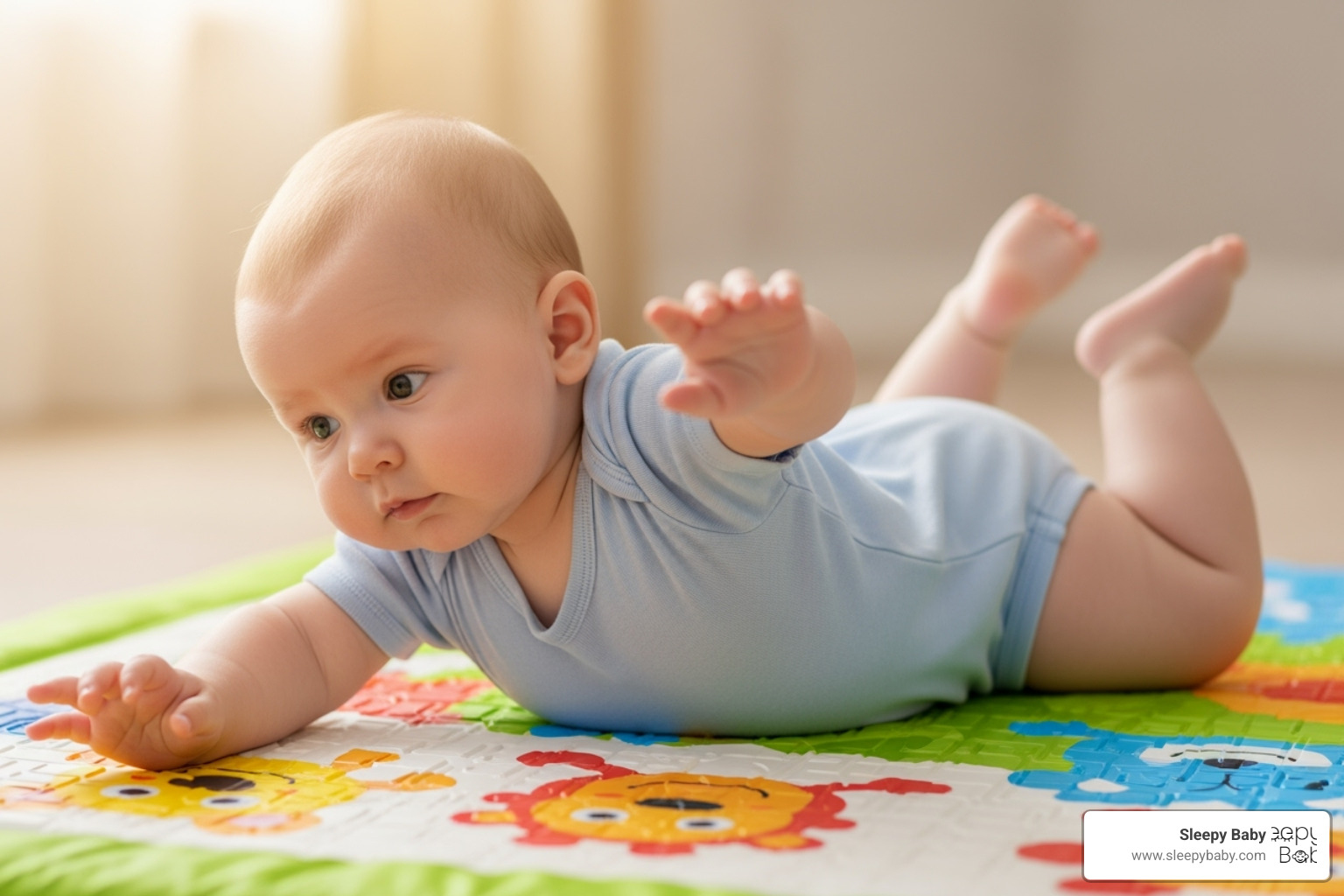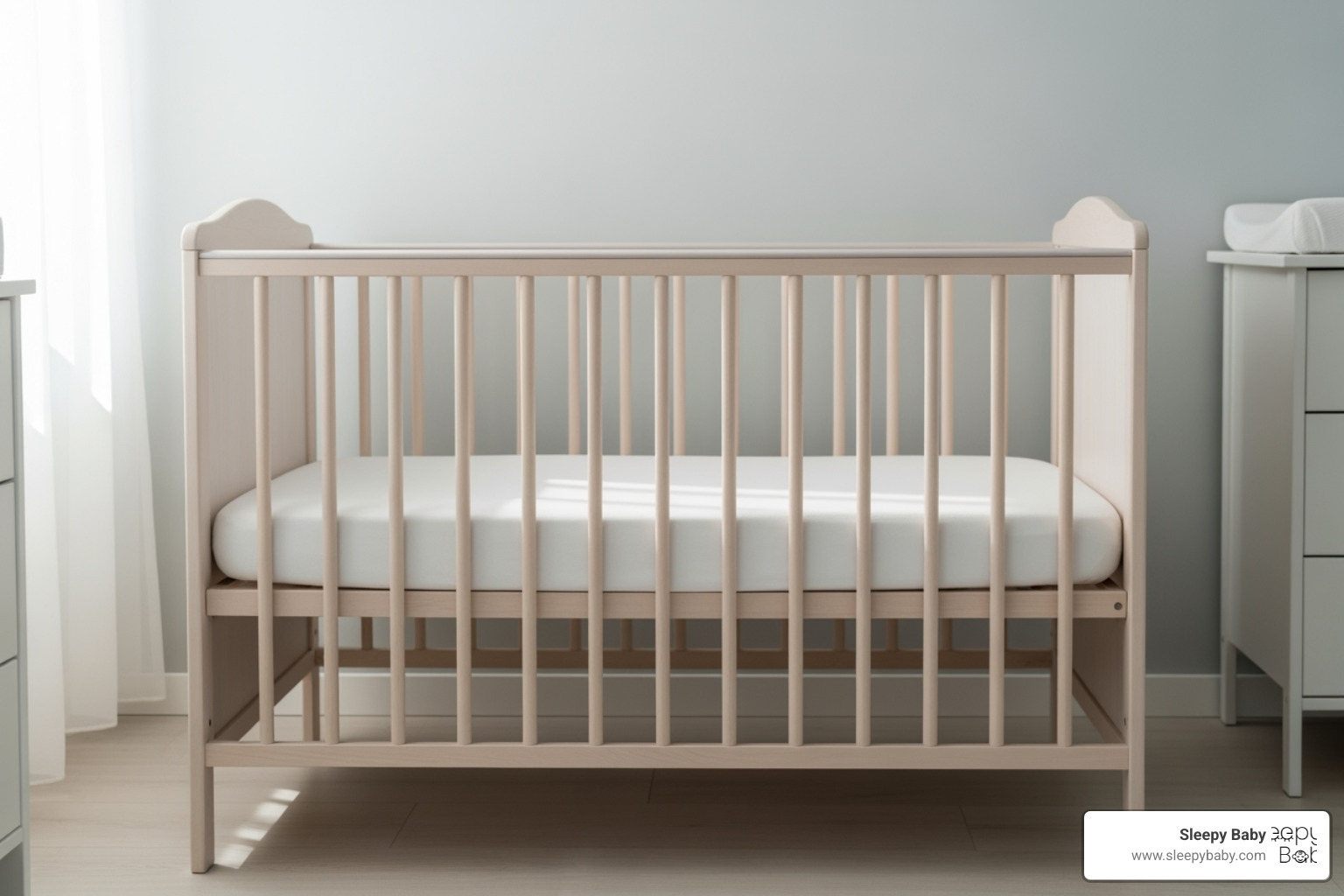The Journey to Peaceful Nights: What Every Parent Needs to Know
Newborn sleeping through the night is a top goal for exhausted parents. However, most babies don't sleep for 6-8 continuous hours until they are at least 3 months old or weigh 12-13 pounds. Every baby's timeline is unique.
Quick Answer for Parents:
- Newborns (0-2 months): Sleep 2-4 hours at a time, need frequent feeding.
- 2-3 months: May sleep 5-6 hour stretches.
- 3-4 months: Most can sleep 6-8 hours (considered "through the night").
- By 6 months: About 62% sleep 6+ hours, and 43% sleep 8+ hours consistently.
The "fourth trimester" can feel endless when you're sleep-deprived. The reality is that newborns are designed to wake frequently. Their tiny stomachs need refueling every 2-3 hours, their sleep cycles are short, and they haven't developed the circadian rhythms that distinguish day from night.
The good news is this phase is temporary. There are proven ways to help your baby (and you) get better rest. At Sleepy Baby, we've developed safe, effective sleep aids to help families find the rest they desperately need on their journey toward newborn sleeping through the night.

The Newborn Sleep Puzzle: Understanding Why They Wake
Newborns need an impressive 14-17 hours of sleep daily, but this sleep comes in short chunks of 2-3 hours. This fragmented pattern is due to several factors.
First, your baby's day-night confusion is normal. After nine months in a dark womb, they haven't developed the circadian rhythms that separate day from night. Their internal clock is still learning.
Second, their tiny stomach size necessitates frequent feeding. At birth, it's the size of a cherry, growing to the size of a ping-pong ball by one week. Breastfed babies typically need to eat every 2-3 hours, while bottle-fed babies can often go 3-4 hours between meals, as formula takes longer to digest. In the early weeks, you may need to wake your baby for feeding until they regain their birth weight.
Finally, newborn sleep cycles are different from ours. They spend about half their sleep in REM sleep, a lighter state crucial for brain development. While adults cycle through sleep stages over 90 minutes, a baby's cycle is only 45-50 minutes, meaning more opportunities to wake. For a deeper dive, check out our Guide to Newborn Sleep Hours.
Newborn Sleep States and Alert Phases
Understanding your baby's states helps you meet their needs.
- Quiet Alert Phase: Your baby is calm, bright-eyed, and engaged. This is a perfect time for gentle interaction.
- Active Alert Phase: They become more animated, moving their arms and legs. They might be getting restless.
- Drowsy State: Their eyes get heavy and movements slow. This is your golden window to start a wind-down routine.
- Crying Phase: If you miss earlier cues, your baby may be overtired and difficult to settle.
Recognizing sleep readiness cues like yawning, eye rubbing, fussiness, or looking away is key to avoiding an overtired baby.
How Feeding Schedules Impact Sleep
Feeding schedules dramatically influence sleep. Two strategies can help encourage longer night stretches:
- Cluster feeding: Offering more frequent feeds in the evening to "top off the tank" before a long sleep.
- Dream feeding: Gently feeding your baby between 10 PM and midnight while they're mostly asleep to add extra calories without fully waking them.
These strategies can help gradually extend sleep, but every baby is different. The key is to be flexible and responsive while gently encouraging longer stretches when they are ready.
The Big Milestone: When is newborn sleeping through the night achievable?
The parenting holy grail, "sleeping through the night," typically means a continuous stretch of six to eight hours. This doesn't mean 7 PM to 7 AM at first, but it's a significant block of rest.
While some babies sleep for 5-6 hour stretches by 2-3 months, most don't achieve this milestone until they are 3-6 months old or weigh around 12 to 13 pounds. This weight often indicates they have enough reserves to last longer without a feeding.
Every baby is unique. Some hit this milestone early, while others take longer. By 6 months, about two-thirds of babies sleep through the night regularly.
How Developmental Milestones Affect Sleep
Just when you figure out sleep, a developmental leap can cause a temporary sleep regression.

- 4-Month Sleep Regression: A baby's sleep patterns mature to be more like an adult's, which can cause more frequent waking as they adjust.
- Object Permanence (4-7 months): Understanding you exist even when out of sight can lead to separation anxiety at bedtime. The AAP has researched these stages and their impact on sleep.
- New Physical Skills: Mastering rolling (4-6 months), sitting up (6-8 months), or crawling (6-10 months) can keep a baby's brain busy at night. You might even find them practicing in the crib at 2 AM!
- Growth Spurts: Occurring around 3, 6, and 9 months, these increase caloric needs and can lead to more night wakings due to hunger.
- Teething: Discomfort from new teeth, which can start months before the first tooth appears around 6 months, often disrupts sleep.
What to expect for newborn sleeping through the night
- Newborns (0-2 months): Sleep in short 2-4 hour bursts. Frequent waking for feeds is normal and necessary.
- 2-4 month olds: Longer 5-6 hour stretches may appear as their circadian rhythm develops. However, the 4-month sleep regression can cause a temporary setback.
- 4-6 month olds: Many babies become capable of sleeping 6-8 hours. They often no longer metabolically need night feedings, making it a good time to focus on consistent sleep habits.
Progress isn't always linear. A week of great sleep might be followed by a few rough nights. Consistency and patience are your best tools. For a year-long overview, see The Sleep Journey: Infant Sleep Patterns in the First Year.
From Dusk 'til Dawn: A Parent's Guide to Better Baby Sleep
Laying the groundwork for healthy sleep habits starts from day one. A consistent routine is one of your most powerful tools, as predictability helps babies understand what's coming next. A simple 15-20 minute routine can work wonders. Our guide, Routine Magic: Creating a Newborn Schedule for Success, can help you build one.
It's also crucial to help your baby learn the difference between day and night.
- Daytime: Accept natural light and normal household sounds during naps. This helps set their internal clock.
- Nighttime: Keep lights dim and interactions minimal. During night feeds, be quiet and boring to teach them that nighttime is for sleep, not socializing.
The "drowsy but awake" method is a foundational skill. Place your baby in their crib when they're sleepy but still alert. This teaches them to fall asleep independently, a key to sleeping for longer stretches.
Sleep Conditioning vs. Sleep Training
You cannot formally sleep train a newborn, but you can begin sleep conditioning from birth.
- Sleep Conditioning (0-4 months): This involves gentle, responsive methods to establish healthy habits without distress. Focus on consistency and meeting your baby's needs. When your baby fusses, try pausing for a minute to see if they resettle. If not, use gentle comfort like patting their chest. Learn more in our article, Can You Really Sleep Train a Newborn?.
- Formal Sleep Training (4-6+ months): Once babies are developmentally ready, more structured approaches can be used. Gentle methods that teach self-soothing with parental support are highly effective, and crying is not required.
Sample Bedtime Routine
A consistent routine signals that it's time to wind down.
- Calming bath: Warm water helps promote sleepiness.
- Infant massage: Gentle strokes can release tension.
- Pajamas and swaddle/sleepsack: Get them comfortable and secure.
- Quiet feeding: Keep the environment calm and dim.
- Story or lullaby: Your soothing voice is a powerful tool.
- Cuddles: A few minutes of quiet snuggles.
- Place in crib drowsy but awake: The final step for independent sleep.
When it comes to safe sleep aids, modern technology offers great options. While some white noise machines can be unsafe if too loud, safety-rated devices provide white noise at safe, low-decibel levels. Rhythmic tapping devices are also very helpful, as they can mimic the comforting pat of a parent's hand, helping babies settle and connect sleep cycles.
Safe & Sound: Creating the Ultimate Sleep Sanctuary
Creating a safe sleep environment is non-negotiable. Following safe sleep guidelines significantly reduces the risk of Sudden Infant Death Syndrome (SIDS) and provides peace of mind.
The foundation of safe sleep is the "ABCs": Alone, on their Back, in a Crib. Your baby should always sleep alone in their own safe space (a crib, bassinet, or play yard), be placed on their back for every sleep, and use a firm, flat surface with only a tightly fitted sheet.

Keep the crib completely bare—no loose bedding, bumpers, or toys. These items pose serious suffocation risks. Dress your baby in one more layer than you would wear to keep them comfortable in a room set to 68-72°F. For full details, review the AAP safe sleep recommendations.
Room-Sharing for Safe Sleep
The AAP recommends room-sharing without bed-sharing for at least the first six months. This means your baby sleeps in your room but in their own separate, safe space. Room-sharing can reduce SIDS risk by up to 50% and makes night feedings much more convenient.
It's critical to distinguish this from bed-sharing, which carries significant risks of suffocation and overlay. Your baby's safety must come first. Our guide on Ensuring Sweet Dreams for Your Newborn offers more tips for setting up a safe sleep space.
The Role of Swaddling and Other Sleep Aids
Swaddling can be a game-changer for newborns, recreating the snug feeling of the womb and controlling the startle (Moro) reflex that can wake them. However, you must stop swaddling when your baby shows signs of rolling over (usually around 4 months), as it becomes a safety hazard.
Pacifiers offered at sleep time may also reduce SIDS risk. White noise can be effective for masking household sounds, but safety is key. While some machines can be too loud, modern safety-rated devices provide sound at safe, low-decibel levels, with some even designed to be placed on the baby's chest. Rhythmic tapping devices are another innovative tool that can mimic a caregiver's touch, promoting longer sleep stretches and giving parents a much-needed break.
Frequently Asked Questions about Newborn Sleep
As parents steer the journey to newborn sleeping through the night, some questions are universal. Here are answers to the most common concerns.
When should I call the doctor about my baby's sleep?
Always trust your parental instincts. Call your pediatrician for:
- Excessive fussiness: Inconsolable crying that could indicate colic, reflux, or another issue.
- Poor weight gain: If sleep issues interfere with feeding and your baby isn't gaining weight appropriately.
- Breathing concerns: Any pauses in breathing, rapid breathing, or unusual noisy breathing.
- Signs of illness: Fever, lethargy, or sudden changes in behavior.
- Any other concerns: It's always better to ask than to worry.
What are common sleep disturbances in newborns?
Even with a perfect routine, challenges can arise.
- Colic: Intense, prolonged crying, often in the evenings, that typically resolves by 3-4 months.
- Gas and digestive discomfort: An immature digestive system can cause gas pain that disrupts sleep.
- Reflux: Stomach contents coming back up can make lying flat uncomfortable.
- Moro (startle) reflex: A normal reflex where a baby's arms flail out, often waking them. Swaddling helps contain this.
- Hunger: The most common reason for waking, due to tiny stomachs and rapid growth.
- Overtiredness: Missing a baby's sleep window can make it even harder for them to settle.
Our guide on Tackling Newborn Sleep Disturbances offers more solutions.
How can I get my newborn to sleep without being held?
Teaching independent sleep is a gift to both you and your baby.
- Use the "drowsy but awake" method: Place your baby in their crib when they are sleepy but still conscious to teach self-soothing.
- Swaddle: A snug swaddle can mimic the security of your arms. Remember to stop when they show signs of rolling.
- Be consistent: A predictable routine helps your baby anticipate and accept the transition to the crib.
- Use safe sleep aids: Modern safety-rated white noise devices provide soothing sounds. Rhythmic tapping devices can mimic a caregiver's gentle pat, offering hands-free comfort that helps your baby settle without being held.
- Be patient: Learning to sleep independently is a skill that takes time and practice.
Conclusion: Your Journey to Restful Nights
The path to a newborn sleeping through the night is a journey, not a race. Newborns aren't designed to sleep for long stretches immediately—their frequent waking is normal and necessary for their development. The key takeaways are that patience and consistency are your greatest allies.
By recognizing sleep cues, establishing a predictable routine, using the "drowsy but awake" method, and prioritizing safe sleep, you are building the foundation for healthy sleep habits.
Every baby is different. Some will sleep through the night at 10 weeks, while others may take until 6 months. What matters most is your consistent approach and being gentle with yourself on challenging nights. Caregiver self-care is essential. You can't pour from an empty cup.
This is why we created Sleepy Baby's intelligent sleep aids. Our devices, featuring rhythmic patting and safe white noise, are designed to mimic your comforting touch, giving you hands-free support. They help your baby learn independent sleep skills while providing you with precious moments of rest.
You are laying the foundation for years of healthy sleep. Be patient, trust the process, and know that restful nights are on the horizon. For more guidance, explore our blog for more expert sleep tips. You've got this.





